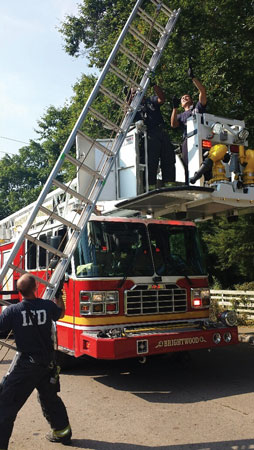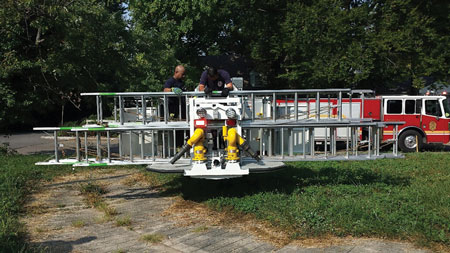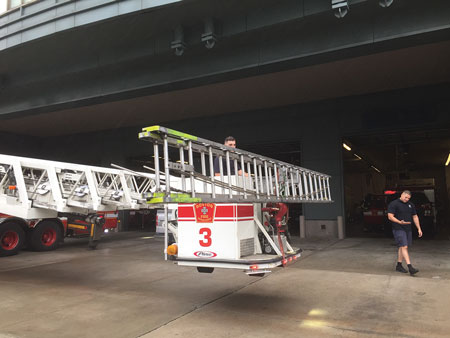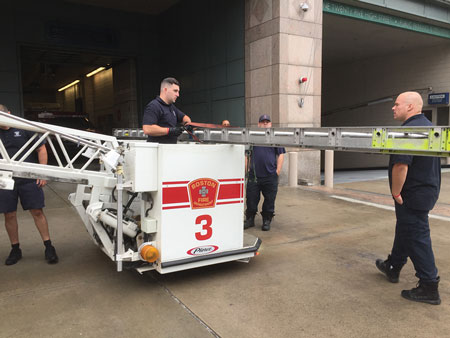
Through the years, firefighters have faced challenging situations and have come up with quick and safe solutions to assist in handling the problem while operating on the fireground. Many of us have had to use muscle and brawn to overcome many situations, although there may have been other means to accomplish the same goal. With the introduction of the tower ladder years ago, we’ve been able to accomplish many tasks faster and more efficiently. We all know how quickly we can get a supply line into the apparatus and begin to flow water vs. setting up an aerial ladder without a prepiped waterway and flow. This article discusses another technique of using a tower ladder to our advantage.
 |
| (1) This large residential complex has limited access to the courtyard, which will hamper getting portable ladders into position to the upper floors. (Photo by Scott Hardin.) |
Many times, firefighters will encounter buildings with stepped-up roofs-buildings that may be one or two stories in the front and multiple stories in the rear. Newer multistory complexes set back from the street are being built that have large atriums or outdoor patios/decks a few levels up that hamper the reach of our aerial and tower ladder apparatus (photo 1). Many of these structures may even have commercial occupancies on the lower floors and apartments or condominiums on the upper floors, which could present a severe life hazard in the event of a fire. Also common on many of the newer buildings are outside balconies that offer the residents a place to relax and entertain. These balconies offer us an area to ladder to perform vent-enter-search operations and also offer the tenants a secondary means of egress in the event of a fire (photo 2). What are your plans to rescue and remove these individuals when you pull up on the scene and your apparatus can’t reach them?
 |
| (2) The glass railing on this balcony is an obstacle that firefighters will have to deal with. Having an alternate plan of ladder transport is a good idea in this situation. (Photo by Scott Hardin.) |
Portable Ladders
In our initial training, many of us learned how to tie a utility rope with a large bowline knot and insert it into the portable ladder and then run it up and over the tip to make a “choker” around the ladder. Next, we placed a hose roller onto the parapet and had the rope run over the rollers, and we used a couple of firefighters to hoist the ladder to the top of the roof. In another evolution, you may have placed two ladders against the same wall of a building about 10 feet apart; then, with a firefighter on each ladder, you pushed a portable up to the roof. When you are performing this up an extension ladder, if you use the “fly-out” principle, you will have to maneuver the ladder over the butt of the fly section when you reach its position. This can be a difficult transition in the evolution and requires good balance and working in unison with the other firefighter on the opposite ladder. Both evolutions require strength and coordination; plus, they can put a physical strain on a firefighter’s endurance. However, we must know the evolutions and train in them for those situations that call for their use (photo 3).
 |
| (3) Sliding a 35-foot portable ladder up two other ladders is strenuous and tiring work. In addition, it takes time, coordination, and communication to perform this tactic safely. (Photo by John Baker.) |
Tower Ladders
Moving portable ladders with the tower ladder bucket might not be a common tactic performed or even trained on, especially if you haven’t been exposed to it. It is definitely a tactic to learn and train on if you have a tower ladder apparatus. It will work on various types of apparatus and bucket styles-with doors that open on the front or sides. Of course, like any tactic, it has some drawbacks; but in many situations, it will reduce your fatigue level and help you achieve your goals.
 |
| (4) With the bucket in the cradle position, firefighters can perform a beam raise with the portable ladder, which allows them to quickly position the ladder through both doors of the bucket. (Photo by John Baker.) |
Side-Opening Bucket Doors
One of the best parts of this evolution for a bucket with side-opening doors is that you can leave the bucket of the apparatus in the cradle and bring the portable ladders to it. There is no need to put the bucket on the ground and then deliver the ladders; that only increases the time it takes to get the ladders to the roof. Firefighters can deliver the ladders from the ladder storage rack to an area next to the apparatus and bucket. Then they will beam raise the ladders so the ladders are in line with the bucket’s doors. The firefighters in the bucket can now hold onto the upper section of the ladder and begin pulling it down while the members on the ground lift up and guide the ladder into position between the open doors (photo 4). Once the ladder is horizontal and supported by the bucket, the firefighter in the bucket will ensure it’s well balanced and sits properly between the open doors.
 |
| (5) Drilling with this evolution will let you know the capabilities of your tower ladder. This unit was able to secure and stow four portable ladders in the bucket. (Photo by John Baker.) |
On most tower ladders, it will be possible to place at least two ladders side by side when using side-opening doors. In some cases, it will even be possible to place four ladders in this space but stacked (two on the bottom, two on the top-photo 5). When raising the second set of ladders, the firefighters on the ground may have to come in at an angle that allows the firefighters in the bucket to grab the ladders. Remember, there are two ladders already in place and sticking outward, so getting a second set of ladders in position will require some skill and coordination.
 |
| (6) The brackets on the front of the bucket easily accept a portable ladder. (Photos 6-8 by Santiago Lasa.) |
Since the ladders sit so well balanced and ride well in this case, you may not have to secure them with a utility rope, tubular webbing, or a hose strap, but I strongly suggest doing so if time and conditions permit. In some instances, depending on your bucket’s characteristics, you may be able to secure the ladders quickly and easily with the premounted retractable safety belts.
Front-Opening Doors
Unfortunately, it won’t be as easy to perform this tactic with buckets that have front-opening doors. Since there are no openings on the sides, the ladders won’t be able to sit secured in position. Instead, follow the same procedures of getting the ladders into position next to the bucket and apparatus when the bucket is left in the cradle. Raise the ladders to the vertical position and when you go to tilt, lift, and slide them upward, the ladders will sit across the upper guide rails of the bucket. If the bucket is on the ground, which takes a little more operational time, hoist the ladders horizontally into position over the rails.
 |
| (7) Installing and using the stokes basket carrying brackets onto the front of the bucket create a ladder rack. |
In tower ladders with permanently mounted controls on the front wall of the bucket, the ladders will have to sit behind the operator if the bucket will be controlled from this position. If it’s going to be controlled from the pedestal, the firefighters can keep the ladders toward the front of the bucket. Both ladders don’t have to be placed next to each other, taking up room; stack them on top of each other to allow more space for the firefighters to operate and move around in the bucket.
 |
| (8) You can place a portable ladder across the top rails of this bucket with front-opening doors. You can also place another ladder on the brackets, enabling you to deliver two ladders at one time. |
When the ladders sit on the bucket’s rails, it is of the utmost importance to secure them to the bucket with some type of lashing. Metal ladders on a metal bucket will slide, no matter how gingerly you move the bucket. Plus, if it’s raining or snowing, chances of sliding will increase. Always use caution and slowly and deliberately move the boom and basket.
Stokes Basket Supports
Many of the new tower ladders have receivers mounted on either the front or sides of the bucket to accept brackets that hold and support a stokes basket. These brackets are often sturdy metal supports that can withstand a great deal of weight (photo 6). They help us remove injured victims, but they can also help us move ladders. Since this will be a little more difficult to perform, it will take proper training to master the skills and learn if your tower ladder is capable of performing this tactic.
 |
| (9) When flying the tower ladder with the ladders extended outside the bucket, always use caution around overhead wires, tree branches, and other obstructions. (Photo by John Baker.) |
It may be advisable to place your bucket on the ground so it’s easier to lift the ladders up and onto the brackets. With some of these brackets, the ladders will be able to hang onto the brackets in a vertical position (photo 7). Only one ladder may fit on the brackets at a time, but there may be the chance another can go through the doors or lie horizontally across the brackets or top rails of the bucket (photo 8). Get out of the firehouse and train with your apparatus and type of brackets to know your capabilities.
Pros and Cons
- After drilling on this, units will learn what capabilities their specific apparatus can perform and the number and size of ladders they’ll be able to travel with. They may also come up with specific ways of securing their ladders in the bucket.
- Anytime ladders are sticking out of the bucket, there is an increased possibility of striking a tree branch, a street light, a parapet, or wires. Always maintain a safe distance from wires; if needed, use another firefighter as a spotter to assist in the raising operation (photo 9).
- Check the maximum weight load of your apparatus bucket so you do not exceed the proper number of ladders and amount of weight (including firefighters in the bucket).
- At nighttime operations, shine lighting on the bucket so the operator at the pedestal and bucket has full vision and avoids hitting anything with the ladders sticking out of the bucket.
- Using the apparatus to transport the ladders reduces the physical exertion members must use and may allow them to perform other functions for longer duration. Also, when operating short-staffed, it will assist in your fireground operations.
Although this tactic won’t be one that you need to perform daily, it is one that tower ladder companies should learn and drill on so they can use their apparatus for more than it was originally designed.
MICHAEL N. CIAMPO is a 30-year veteran of the fire service and a lieutenant in the Fire Department of New York. Previously, he served with the District of Columbia Fire Department. He has a bachelor’s degree in fire science from John Jay College of Criminal Justice in New York City. He is the lead instructor for the FDIC Truck Essentials H.O.T. program. He wrote the Ladder chapter and co-authored the Ventilation chapter for Fire Engineering’s Handbook for Firefighter I and II (Fire Engineering, 2009) and is featured in “Training Minutes” truck company videos on www.FireEngineering.com.
Michael N. Ciampo will present “Tower Ladder Tactics and Tips” on Thursday, April 21, 1:30 p.m.-3:15 p.m., at FDIC International 2016 in Indianapolis.
Training Minutes: Moving Portable Ladders
TOWER LADDERS: POSITIONING TIPS AND TECHNIQUES
MORE ON TOWER LADDERS, PART 1
MORE ON TOWER LADDERS
Fire Engineering Archives

